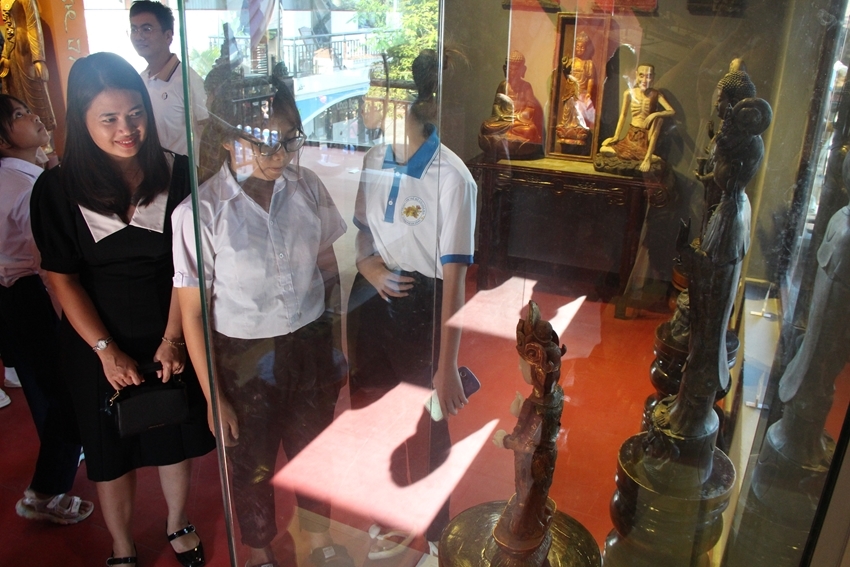 |
| A corner of space of the Cecile Le Pham Museum of Fine Arts appealing to viewers |
To date, Hue has had 5 non-public museums: Museum of Nguyen Dynasty-style Porcelain, Museum of XQ Embroidery Art, Huong River Museum of Ancient Pottery, Museum of General Nguyen Chi Thanh and Cecile Le Pham Museum of Fine Arts.
Aside from diversifying cultural institutions, non-public museums also play a vital role by supporting public museums in spreading and promoting the cultural and historical values of the land. Since its establishment in April 2022, the Huong River Museum of Ancient Pottery (120 Nguyen Phuc Nguyen, Hue City) has become a bright spot on the tourism map.
Entering this space, visitors will be amazed by the huge quantity of antiques, telling the story of the river with a long history from ancient times to the modern period. Visitors seem to be "captivated" by the lime pots, jars, plates, bowls... picked out from the romantic river right ahead of the house-cum-exhibition space.
Referring to the non-public museum system, we cannot but mention the Museum of Nguyen Dynasty-style Porcelain (114 Mai Thuc Loan, Hue City) - the first non-public museum in Hue, established by researcher Tran Dinh Son in 2013. After more than ten years of operation, this museum has become a destination for lovers of antiques, especially Nguyen Dynasty-style porcelain. In addition, at that place, viewers will come across many elite handicraft products of the feudal dynasties of Vietnam, especially the Nguyen Dynasty, made of materials such as gold, silver, jade, ivory, bronze, wood, bamboo, ceramic... as well as "four hobbies" of the ancients: chewing betel, drinking tea, smoking and drinking wine.
Mr. Nguyen Thai, a tourist from Ho Chi Minh City was astonished to learn that Hue, a small city, has up to 5 non-public museums. Traveling to Hue, he spent time going to many museums and felt the appeal from the artifacts to the space arranged and exhibited by the museum owners.
“I am quite impressed with the Huong River Museum of Ancient Pottery. These artifacts help me have some knowledge of the Huong River and further, understand the story of Hue from the river. It must be said that these private museums not only display in-depth thematic artifacts but also show their owners’ ingenuity in organization," said Mr. Thai.
 |
| The Huong River Museum of Ancient Pottery - one of Hue's non-public museums |
In addition to the designated non-public museums, the Le Ba Dang souvenir space located on Kim Son Hill (Thuy Bang commune, Hue City) is also known as a “thriving” non-public cultural destination. After 4 years of operation, this space has become a highlight on the tourism map when many travel companies incorporate it into tours to serve visitors. A great many international tourists, after reaching Hue to visit the monuments, also came here and were impressed by the professionalism and methodicalness from the space to the arrangement of artworks.
“Aside from the exquisite architecture, meeting the exhibition function correctly, the design of lighting systems and display of each work inside that space can be said to be classy. Few private spaces in Vietnam can achieve such professionalism," affirmed Ms. Hoai Trinh, a tourist from Hanoi. Therefore, this tourist thinks that spending money on a ticket to visit this space is “to get his money’s worth".
Dr. Phan Thanh Hai, Director of the Department of Culture and Sports, said that non-public museums are currently collecting and storing tens of thousands of valuable artifacts, contributing to the preservation and exhibition of artifacts.
Despite not regularly organizing the exhibition activities like public museums, non-public museums have held the exhibitions of documents and artifacts collected according to topics. Since their inception, with all their difficulties, museums have held interest to the public. Besides, non-public museums have positively overcome the loss of antiques.
In Mr. Hai’s view, to help non-public museums develop, the authorities made many decisions such as real estate rental prices, supporting exhibition activities, supporting the development of typical souvenir products, supporting the training and fostering of human resources, supporting image promotion…